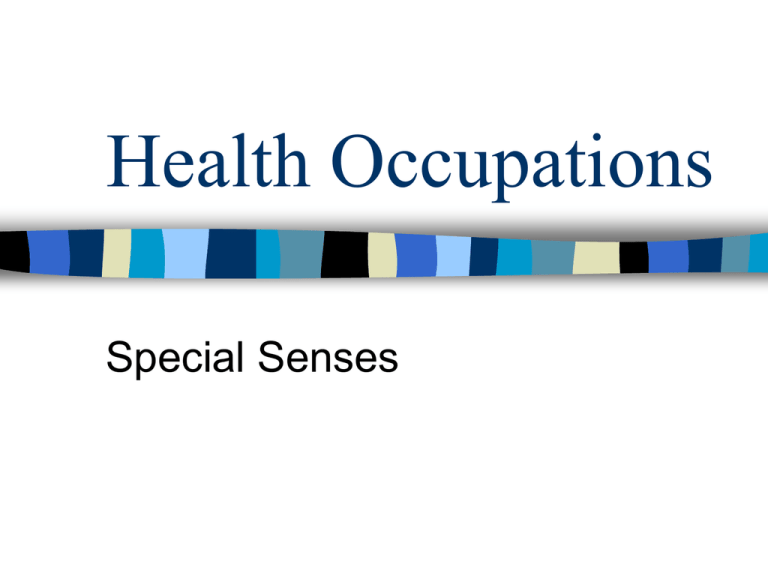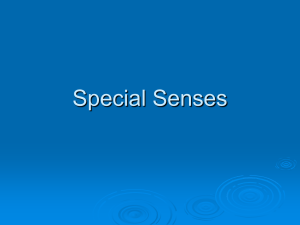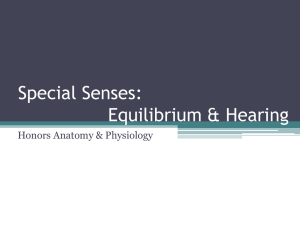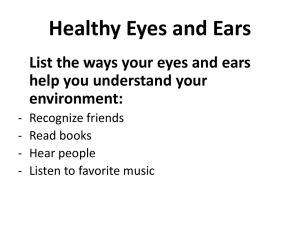HOC 1 - 15 Special Senses
advertisement

Health Occupations Special Senses Functions of our special senses Allows human body to react to environment Enables the body to – – – – – See Hear Taste Balance Smell Can occur because body has structures that – Receive sensation – Nerves that carry sensory messages to brain – Brain that can interpret & respond to message Eye Organ that controls sight Eye – Receives light rays – Transmits rays to optic nerve – Optic nerve carries rays to brain – Brain interprets rays as vision or sight Protection of eye Bony socket of skull – Partially enclosed Eye lids & lashes – Help keep out dirt & pathogens Lacrimal glands – Produce tears which moisten & cleanse eye – Tears flow across eye, drain through lacrimal duct into nasal cavity Conjunctiva – Mucous membrane that protects eye – Lines eyelids & covers front of eye – Provides protection & lubrication 3 main layers of eye Sclera – – – – – Outermost layer Tough connective tissue White of eye Maintains eye shape Extrinsic muscles • Responsible for moving eye in socket • Attach to outside of sclera – Cornea • Circular transparent part on front of sclera • Allows light rays to enter eye 3 main layers of eye Choroid coat – Middle layer of eye – Interlaced with many blood vessels that nourish eye – Pupil • Hole in front of choroid coat • Allows light rays in – Iris • Colored part of eye • Muscle that controls the size of the pupil & regulates amount of light entering eye 3 main layers of eye Retina – Innermost layer – Made of many layers of nerve cells that transmit light to the optic nerve – 2 types of cells in retina • Cones – Used for light vision – Sensitive to color – Located in depression on back of retina (FOVEA CENTRALIS) which is the area of sharpest vision • Rods – Used mainly for dim or dark vision Other special structures Lens – Circular structure behind pupil – Suspended in place by ligaments – Refracts (bends) light rays so that the rays will focus on the retina Aqueous humor Clear watery fluid found in anterior chamber of eye Fills space between cornea & iris Helps maintain forward curvature of eyeball Bends (refracts) light rays Vitreous humor Jelly like substance found in posterior chamber of eye Fills area behind lens Helps maintain eyeball shape Also bends or refracts light rays 2. Suspensory ligament 3. Conjunctiva 4. Iris 1. Ciliary body & muscle 5. Pupil 6. Path of light 17. Anterior Chamber (aqeuous humor) 16. Retina 15. Retinal arteries And veins 14. Fovea centralis 13. Optic nerve 7. Cornea 12. Choroid coat 8. Lens 11. Sclera 9. Suspensory ligament Posterior chamber (vitreous humor) Refraction of light rays As light enters eye, it passes through a series of parts that refracts it Rays pass through cornea, aqeuous humor, pupil, lens, & vitreous humor Focus on fovea centralis, the area of retina that has sharpest vision and the most nerve cells In retina, rays are picked up by rods & cones – Changed into nerve impulses – Transmitted by the optic nerve to the occipital lobe of cerebrum – Sight can be interpreted by cerebrum If rays are not refracted correctly, vision is distorted or blurred Abnormal eye conditions Amblyopia – Lazy eye – Common in early childhood – Results in poor vision in one eye • Due to dominance in other eye – Treatment • Cover good eye to stimulate development of lazy eye • Exercises to strengthen weak eye – If untreated before 8-9 years of age • Blindness of weak eye may occur Astigmatism Abnormal shape or curvature of cornea Causes blurred vision To correct, apply corrective lenses Light rays focus on multiple areas of retina Cataracts Normally clear lens becomes cloudy or opaque Occurs gradually, usually result of age May be caused by trauma Symptoms – – – – Blurred vision Halos around lights Gradual vision loss Milky white pupil in late stages Cataracts Treatment – Surgical removal of lens – Implant intraocular lens – New glasses or contacts Conjunctivitis Pink eye Contagious inflammation of conjunctiva Causes – bacteria or virus Symptoms – – – – Redness Swelling Pain Pus formation Treatment – Antibiotics, usually ointment Glaucoma Results from increased intraocular pressure Caused by excess aqueous humor in anterior chamber of eye Common after age 40 Leading cause of blindness Tonometer – instrument used to measure IOP, used during every eye exam Symptoms – – – – Loss of peripheral vision Halos around lights Limited night vision Mild aching Glaucoma treatment Controlled with meds – Decrease amount of aqueous humor – Improve drainage of aqueous humor Surgery to create an opening for the flow of aqueous humor Hyperopia Farsightedness Light focuses behind retina Can see far away NOT near Correct with glasses or contacts convex Myopia Nearsightedness Light rays are refracted too sharply & focus in front of retina Can see near NOT far away Corrected by concave lenses Can correct with surgery or lasers Presbyopia Farsightedness Caused by loss of lens elasticity Occurs as a result of normal aging Treated with reading glasses Strabismus Eyes do not focus or move together Eyes may be cross-eyed inwardly, outwardly, or up & down Caused by muscle weakness in one or both eyes Treatment – – – – Eye exercises Covering good eye Corrective lenses Surgery on muscles moving eye Ear Organ that controls hearing & balance 3 main sections – outer, middle, inner Hearing – Transmits impulses from sound waves to auditory nerve (vestibulocochlear) – Auditory nerve carries impulses to brain – Brain interprets as hearing Outer ear Auricle or pinna – Visible part of ear – Elastic cartilage covered by skin – Leads to canal called the external auditory meatus and auditory canal Auditory canal – Contains special ceruminous glands producing cerumin (wax) for protection – Sound waves travel through this to reach tympanic membrane Tympanic membrane – Separates external & middle ear – Vibrates when sound hits it – Transmits sound waves to middle ear Middle Ear Small space or cavity in temporal bone Contains 3 small bones (ossicles) – Malleus – Incus – Stapes Bones connected & transmit sound waves from tympanic membrane to inner ear Eustachion tube – Tube connecting middle ear to pharynx that allows air to enter the middle ear – Helps to equalize pressure on both sides of tympanic membrane Inner ear Most complex part of ear Oval window – Membrane separating inner & middle ear Vestibule – First section acting as entrance to 2 other parts of inner ear Cochlea – Snail shaped – Contains delicate hair like cells that make up ORGAN OF CORTI – Receives sound waves & transmits impulses to auditory nerve Inner ear Semicircular canals – Contain liquid & hair like cells – Bend when liquids move with head & body movements – Impulses sent to cerebellum to help maintain balance & equilibrium 1. Not pictured Pinna or auricle 4. Malleus 5. Incus 7. Semicircular canals 8. Auditory nerve 9. Cochlea 2. External auditory canal 10. Oval window 3. Tympanic membrane 6. Stapes 11. Eustachion tube Abnormal conditions Hearing loss – 2 types – Conduction • Caused by sound waves not being conducted to inner ear • Causes – – – – – Cerumen plug Foreign body obstruction Otosclerosis Infection Ruptured tympanic membrane • Treatment – Eliminate cause – Surgery – Hearing aids Sensory hearing loss Caused by damage to inner ear or auditory nerve Usually can NOT be corrected Cochlear implants can improve severe hearing loss Meniere’s disease Collection of fluid in labyrinth of the inner ear & degeneration of hair cells in cochlea & vestibule Symptoms – – – – Severe vertigo or dizziness Tinnitus (ringing in ears) N&V Loss of balance & tendency to fall Treatment – Drugs to reduce fluids & antihistamines – Drainage of fluid – Surgery to destroy cochlea in severe cases (causes permanent deafness) Otitis externa Inflammation of external auditory canal Variety of causes – Swimmer’s ear – Inserting foreign objects (bobby pins, fingernails, cotton swabs) Treatment – Antibiotics – Warm moist compresses – Pain meds Otitis media Inflammation or infection of middle ear Causes – bacteria or virus Frequently follows sore throat because organisms can enter ear through Eustachion tubes Susceptible – – Infants & young children – Eustachion tube is angled differently than in adults & secretions from nose & throat accumulate in middle ear – This causes inflammatory response that causes tube to swell shut Otitis media Symptoms – – – – – – Severe pain Fever Vertigo Dizziness N&V Buildup of fluid in middle ear Treatment – Antibiotics & pain meds – Myringotomy & tubes Otosclerosis Stapes becomes immobile & causes conductive hearing loss Symptoms – Gradual hearing loss – Tinnitus – vertigo Treatment – Surgical removal of stapes – Insertion of artificial stapes Taste Dependent on taste receptors located on tongue – Tongue is mass of muscle tissue with projections called papillae – Papillae contain taste buds which are stimulated by flavors & moistened by saliva Four main tastes – Sweet & salty – tip of tongue – Sour – sides of tongue – Bitter – back of tongue Influenced by smell Smell Nose is organ Determined by olfactory receptors in upper part of nasal cavity Impulses from receptors are carried to brain by olfactory nerve Sense of smell closely related to taste – Smell much more sensitive – Human nose can detect over 6,000 different smells Skin & general senses General sense receptors for pressure, heat, cold, touch, & pain located throughout body in skin & connective tissue Each receptor perceives only 1 type of sense Messages from receptors allow human body to respond to environment Helps body to react to conditions that could cause injury









